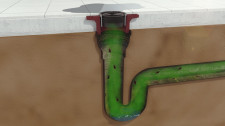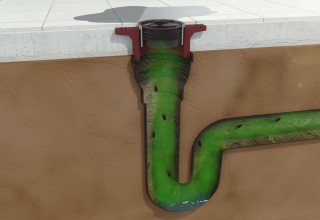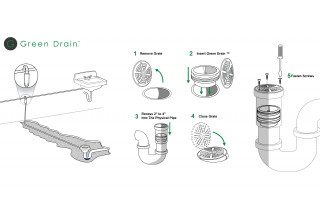Are Businesses Prepared to Handle Infection Control?

CHARLOTTE, N.C., November 11, 2020 (Newswire.com) - As both U.S. and international businesses attempt to continue day-to-day operations with the winter season approaching, many business owners and operators are considering the steps necessary to protect their clientèle from transmissible illnesses in the months to come. The team behind the GREEN DRAIN™, an environmentally friendly water-free trap seal, is actively warning both business owners and consumers about the dangerous spread of microorganisms in drainage systems.
In an effort to help businesses best position themselves for the future, the GREEN DRAIN™ team has aggregated a series of approaches that business owners can take to manage infection control and prevent the spread of dangerous diseases.
Upgrades to HVAC Systems:
HVAC systems can potentially spread viruses across rooms in indoor settings. When high-speed air flows past an infected person to others, this can cause high levels of transmission in a very short amount of time. According to the New England Journal of Medicine, this event has occurred in the past, most notably in 2003 with the spread of Severe Acute Respiratory Syndrome (SARS) in Hong Kong, China.
Per McKinsey & Company, there are a multitude of control-setting changes and upgrades that can help decrease the risk of spread in areas with high-speed airflow. In buildings with old or inflexible systems, technicians might consider upgrading HVAC hardware, which may include replacing fixed-speed fan motors with variable-speed ones to enhance the control of airflow and allow for a minimum setting that produces lower airflow speed. Technicians can also introduce sophisticated airflow-control systems, such as those that are sensitive to pressure, to allow for smoother adjustment of airflows, or install high-performance air-purification systems.
Business owners can also try to increase the percentage of outdoor air, (e.g., using economizer modes of HVAC operations), potentially as high as 100%. However, owners must first verify compatibility with HVAC system capabilities for both temperature and humidity control as well as compatibility with outdoor/indoor air quality considerations. Owners may also attempt to increase total airflow supply to occupied spaces, disable demand-control ventilation (DCV) systems that reduce air supply based on temperature or occupancy, or consider using natural ventilation (i.e., opening windows if possible and safe to do so) to increase outdoor air dilution of indoor air when environmental conditions and building requirements allow.
By taking such actions, business owners may be able to help their tenants feel more comfortable amid the uncertainty brought about by the ongoing health crisis.
Improvements to Indoor Air Filtration:
The HVAC systems found in the majority of commercial buildings are not configured with air filtration systems that effectively remove biological contaminants (particularly bacteria and viruses) from the air.
Researchers have increasingly called for measures to ensure proper ventilation, especially in businesses and schools. These measures include increasing outdoor air circulation in buildings and making sure air filters are up to grade.
The CDC recommends increasing the total airflow supply and percentage of outdoor air to occupied spaces.
Eliminating Spread of Microorganisms in Drainage Systems:
With waterborne pathogens traveling through the drainage systems commonly found in commercial properties, the transmission rates of viruses can spike if the issue is left unresolved.
Problems such as infections as well as the emergence of multi-resistant bacteria arise when the sanitation system is not working properly; primary examples of malfunction include leakage and backflow caused by blockages or dried out traps. Biofilm, which is a collection of microorganisms in drain lines, is another persistent issue for many business owners. As it stands, no product on the market cleans and eliminates biofilm entirely. GREEN DRAIN™ can prevent cross-contamination of aerosolized pathogens caused by faulty or evaporated traps.
"Traditional cleaning methods are largely ineffective against biofilm and other microorganisms, but the GREEN DRAIN™ fights against deadly pathogens such as listeria and salmonella by leveraging its revolutionary silicone skirt technology," said Jason Bocchino, CEO of GREEN DRAIN™.
To create a COVID-19 workplace health and safety plan, please visit https://www.cdc.gov/coronavirus/2019-ncov/community/office-buildings.html.
For more information about The GREEN DRAIN™ and how to keep your business safe from the transmission of potentially dangerous diseases, please visit http://www.greendrains.com.
About The GREEN DRAIN™
The GREEN DRAIN™ is an environmentally friendly, water-free trap seal, which can be installed in basically all floor drains without the use of tools.
Contact Information:
Media Inquiries: Morganpr@newswiremail.com
Sales: sales@greendrains.com
Source: GREEN DRAIN™


